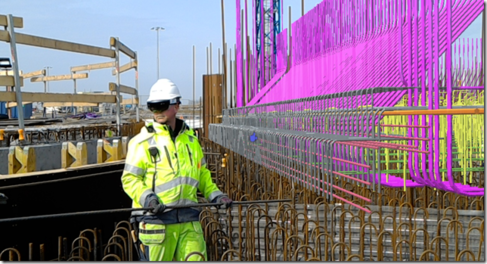There are so many scenarios to consider.
You have your server system – do this with MDriven Turnkey. Pages that attract MANY users you create as MVC – pages that require desktop feel you do with AngularJS – or even WPF– no need to go cheap – you can do it all – its just a setting per form.
Then you also want user to get information and supply data on the go – use Cordova to display some or all of your server system in a specific app – and with the abilities of html5 – to access position etc. – you may not even need an app for this.
When all that is done you are left with the users that work offline… GodDamnOfflineUsers – do they exist? Yes – the ones we see now work with a Hololens doing reinforce bars planning and production on ESS in Lund. Standing so close or in the middle of these steel bars effectively shields you from all radio – wifi or WCDMA. And even if we could get radio in there – they would soon be in tunnels and under ground construction sites or in special buildings designed to shield radio (hospital X-ray rooms).
Picture is shown courtesy of http://informationexperience.se – look them up for augmented reality today.
There are offline users. Bite the bullet.
In this video I take the Default Xamarin Forms template app and make it run with MDriven. I remove a lot of manual written code and make the data persistent on the device.
In future sessions – if there is interest – we can build on this and sync locally changed data to a Turnkey server using rest api’s.
We can also – again – if there is interest – we can add a Barcode scanner to the app and maybe have that look up data on the server if we are online – or just cache it if we do not have internet access.
Some important code snippets from the video:
private EcoProject1EcoSpace _es;
protected override void OnCreate(Bundle bundle)
{
…
_es=new EcoProject1EcoSpace();
_es.PMapperXml.OnLoadAsXML += Pm_OnLoadAsXML;
_es.PMapperXml.OnSaveAsXML += Pm_OnSaveAsXML;
ViewModelDefinitionsInApplication.Init(_es);
_es.Active = true;
BaseViewModel.DataStore.SetEcoSpace(_es);
…
}
private void Pm_OnSaveAsXML(object sender, Eco.Persistence.OnSaveAsXMLArgs e)
{
var path = global::Android.OS.Environment.ExternalStorageDirectory.AbsolutePath;
var filename = System.IO.Path.Combine(path.ToString(), e.FileName);
e.XDocumentToSave.Save(filename);
e.ContinueWithDefault = false;
}
private void Pm_OnLoadAsXML(object sender, Eco.Persistence.OnLoadAsXMLArgs e)
{
var path = global::Android.OS.Environment.ExternalStorageDirectory.AbsolutePath;
var filename = System.IO.Path.Combine(path.ToString(), e.FileName);
if (System.IO.File.Exists(filename))
{
using (var fileStream = System.IO.File.OpenRead(filename))
{
using (var streamReader = new System.IO.StreamReader(fileStream))
{
e.LoadedDataAsXml = streamReader.ReadToEnd();
e.ContinueWithDefault = false;
}
}
}
}
And this is how you instantiate a code generated viewmodel:
viewModel = DMItemsViewModel.Create(BaseViewModel.DataStore.GetEcoSpace(), null);

